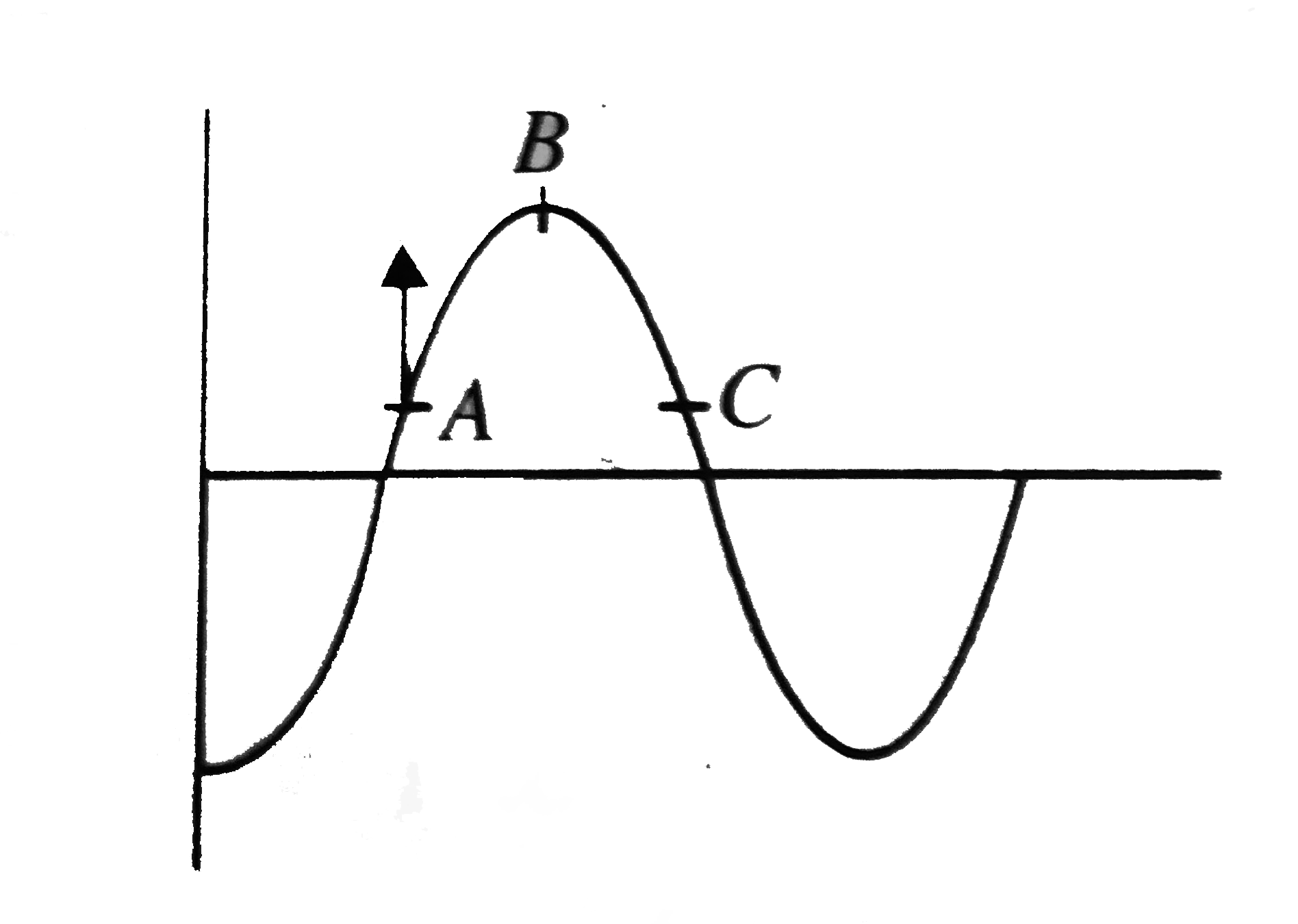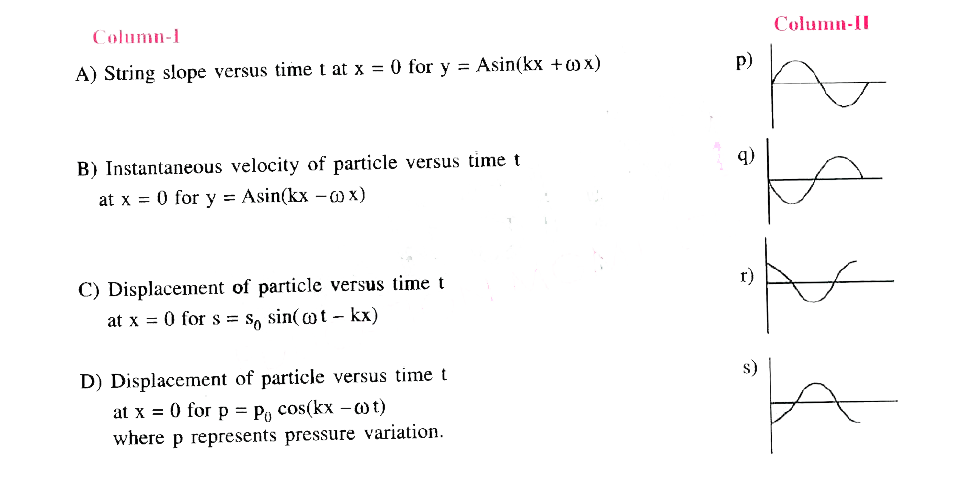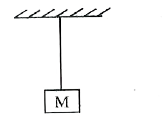A wire of length L, is hanging vertically from a rigid support. If a transverse wave pulse is generated at the free end of wire then which of the following statement is wrong
Velocity at bottom end is zero
Velocity at top end is √gL
Time taken to reach the top end is 2√Lg
Acceleration of wave is g
The correct Answer is:D
To solve the problem, we need to analyze the statements regarding the behavior of a transverse wave pulse generated in a vertically hanging wire. Let's go through the statements one by one to identify which one is incorrect.
Step 1: Analyze the first statement
Statement: Velocity at the bottom end is 0.
- At the bottom end of the wire, the displacement (x) is 0 because it is fixed to a support.
- The velocity of the wave can be expressed as v=√g⋅x.
- Substituting x=0 gives v=√g⋅0=0.
Conclusion: This statement is correct.
Step 2: Analyze the second statement
Statement: Velocity at the top end is √g⋅L.
- At the top end of the wire, the displacement (x) is equal to the length of the wire (L).
- Using the same formula for velocity, we have v=√g⋅L.
Conclusion: This statement is also correct.
Step 3: Analyze the third statement
Statement: Time taken to reach the top end is 2√Lg.
- The time taken for the wave to travel the length of the wire can be calculated using the formula t=Lv.
- Substituting v=√g⋅L, we get t=L√g⋅L=√L2g⋅L=√Lg.
- However, this is the time for the wave to travel to the top, not double that value.
Conclusion: This statement is incorrect.
Step 4: Analyze the fourth statement
Statement: Acceleration of the wave is g.
- The relationship between velocity and displacement is given by v2=g⋅x.
- Differentiating with respect to time gives 2vdvdt=gdxdt.
- Using dxdt=v, we can express acceleration a as a=dvdt=g2v.
- This indicates that the acceleration is not equal to g but rather g2.
Conclusion: This statement is also incorrect.
Final Conclusion
The statement that is wrong is the one regarding the time taken to reach the top end, which is incorrectly stated as 2√Lg. The correct time is √Lg.
Summary of the Incorrect Statement
- Incorrect Statement: Time taken to reach the top end is 2√Lg.
Statement: Velocity at the bottom end is 0.
- The velocity of the wave can be expressed as v=√g⋅x.
- Substituting x=0 gives v=√g⋅0=0.
Conclusion: This statement is correct.
Statement: Velocity at the top end is √g⋅L.
- Using the same formula for velocity, we have v=√g⋅L.
Conclusion: This statement is also correct.
Statement: Time taken to reach the top end is 2√Lg.
- Substituting v=√g⋅L, we get t=L√g⋅L=√L2g⋅L=√Lg.
- However, this is the time for the wave to travel to the top, not double that value.
Conclusion: This statement is incorrect.
Statement: Acceleration of the wave is g.
- Differentiating with respect to time gives 2vdvdt=gdxdt.
- Using dxdt=v, we can express acceleration a as a=dvdt=g2v.
- This indicates that the acceleration is not equal to g but rather g2.
The statement that is wrong is the one regarding the time taken to reach the top end, which is incorrectly stated as 2√Lg. The correct time is √Lg.
- Incorrect Statement: Time taken to reach the top end is 2√Lg.
Topper's Solved these Questions
- WAVE MOTIONBOOK - AAKASH SERIESCHAPTER - WAVE MOTIONEXERCISE - LECTURE SHEET (EXERCISE-II (LEVEL-II(ADVANCED) STRAIGHT OBJECTIVE TYPE QUESTIONS))
6 Videos
- WAVE MOTIONBOOK - AAKASH SERIESCHAPTER - WAVE MOTIONEXERCISE - LECTURE SHEET (EXERCISE-II (LEVEL-II(ADVANCED) MORE THAN ONE CORRECT ANSWER TYPE QUESTIONS))
4 Videos
- WAVE MOTIONBOOK - AAKASH SERIESCHAPTER - WAVE MOTIONEXERCISE - LECTURE SHEET (EXERCISE-I (LEVEL-II(ADVANCED)MATRIX MATCHING TYPE QUESTIONS))
1 Video
- UNITS AND MEASUREMENTSBOOK - AAKASH SERIESCHAPTER - UNITS AND MEASUREMENTSEXERCISE - EXERCISE -3
66 Videos
- WAVE MOTION AND SOUNDBOOK - AAKASH SERIESCHAPTER - WAVE MOTION AND SOUNDEXERCISE - PROBLEMS (LEVEL - II)
97 Videos
Similar Questions
A wire of variable mass per unit length μ=μ0x, is hanging from the ceiling as shown in figure. The length of wire is l0 . A small transverse disturbance is produced at its lower end. Find the time after which the disturbance will reach to the other ends.

View SolutionA wave is travelling along a string. At an instant shape of the string is as shown in the enclosed figure. At this instant, point A is moving upwards. Which of the following statements are correct?

View SolutionSymbols have their usual meanings. Match the Column-I with Column-II:

View SolutionThe length of a rectangular plate is measured as 10 cm by a vernier scale of least count 0.01 cm and its breadth as 5 cm by the same scale. The percentage error in area is
View SolutionA wave is described by the equation y=(1.0mm)sinπ(x2.0cm−t0.01s).
(a) Find time period and wavelength.
(b) Find the speed of particle at x=1.0cm and time t=0.01s.
( c ) What are the speed of the partcle at x=3.0cm, 5.0cmand7.0cm at t=0.01s?
(d) What are the speeds of the partcle at x=1.0cm at t=0.011 , 0.012and0.013s?
View SolutionA metal wire of length L is suspended vertically from a rigid support. When a bob of mass M is attached to the lower end of wire, the elongation of the wire is l:
View SolutionA string is hanging from a rigid support. A transverse
pulse is excited at its free end. The speed at which the
pulse travels a distance x is proportional to
View SolutionA uniform rope having some mass hinges vertically from a rigid support. A transverse wave pulse is produced at the lower end. The speed (v) of the wave pulse varies with height (h) from the lower end as :-
View SolutionA uniform wire of length 12 m and mass 6 kg is suspended from a rigid support. A mass of 2 kg is a attached to the lower free end. A transverse wave of length 0 . 0 6 m is generated at the lower end of the wire . What is its wavelength when the wave reaches the upper end ?
View SolutionA string of length l hangs freely from a rigid support. The time required by a transverse pulse to travel from bottom to half length of the string is
View SolutionA uniform rope of length 20 m and mass 5 kg is hanging vertically from a rigid support. A block of mass 4 kg is attached to the free end. The wave length of the transverse wave pulse at the lower end of the rope is 0.04 m. The wavelength of the same pulse as it reaches the top is
View SolutionA wire of length L, is hanging vertically from a rigid support. If a transverse wave pulse is generated at the free end of wire then which of the following statement is wrong
View SolutionA uniform rope having mass m hangs vertically from a rigid support. A transverse wave pule is produced at the lower end. The speed v of wave pulse varies with height h from the lower end as:
View SolutionA uniform rope having mass m hangs vertically from a rigid support. A transverse wave pule is produced at the lower end. The speed v of wave pulse varies with height h from the lower end as:
View SolutionA uniform rope having some mass hangs vertically from a rigid support. A transverse wave pulse is produced at the lower end. The speed (v) Of the wave pulse varies with height (h) from the lower end as:
View SolutionA load of mass M is attached to the free and of a uniform wire of mass m as shown in figure. If a transverse wave pulse is generated at the lower end of wire, find the ratio of velocity of wave at bottom end and at top end of wire:

View Solution

